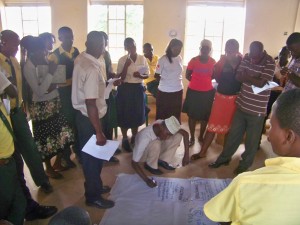By Serunjogi Francis, Communications Officer

According to the Uganda demographic survey, 26.4% of the girls between the ages of 15 and 19 are sexually active and can readily give birth. On the other hand, 16 million girls under the age of 16 years give birth each year worldwide (United Nations Populations fund). A community intervention recommended that if the girl child is to be protected, early sexual reproductive health literacy training should be done.
This should be complemented with creation of awareness on contraception use, accessibility and availability of reproduction health services. This will save these young people from getting “unwanted” pregnancies, and will also avail them with basic knowledge about HIV AIDS and other STIs. Creating awareness through sensitization programs is highly recommendable.
Interventions can include, making out reaches to education institutions by different stake holders to talk to students about sexual reproductive health and can create more impact if parents and teachers are involved. On the other hand, having students in closed sessions with health practitioners make it easier for them to open.
On 6th June 2013 the Center for Health Human Rights and Development (CEHURD) organized a Health Literacy Program in the Districts of Kiboga and Kyankwanzi. The aim of the training was to facilitate community participation in improving sexual reproductive health (SRH) for the youth of Mulagi, Wattuba and Gayaza sub-counties using the Participatory Reflection Action (PRA) processes.
The programme was carried out in Buyimbaazi Senior secondary school and aimed at improving youth knowledge in SRH and to strengthen relations with health workers and the health system in general by engineering discussions on youth friendly services.
The training included technical and vocational schools which enabled to reach out to youth that are not in secondary schools for reasons such as dropping out of school due to early teenage pregnancy.
According to Nantaba Juliana, the programme Officer, Community Empowerment Programme at CEHURD, “Health literacy refers to people’s ability to obtain, interpret and understand basic health information and health services and to use such information and services in ways that promote their health.”
The Health Literacy program gives an all-inclusive approach to SRH with the perspective that the boy child too has a role to play. This draws away from the common Health Literacy on SRH that is only focused to the girl child.
Generally it is important to mobilize the wider communities to join efforts to meet the sexual reproductive health needs of the youth. Emphasis should be put on both girls and boys.
